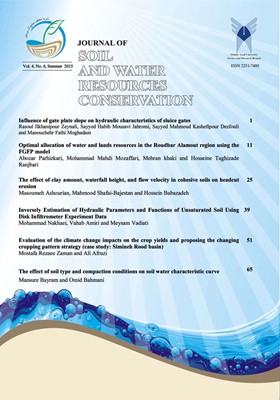Evaluation of the climate change impacts on the crop yields and proposing the changing cropping pattern strategy (case study: Simineh Rood basin)
Subject Areas : Farm water management with the aim of improving irrigation management indicatorsMostafa Rezaee Zaman 1 , Ali Afruzi 2 *
1 - Former M.Sc. Student of Water Resources Engineering Department, Faculty of Agriculture, Tarbiat Modares University, Tehran, Iran
2 - Young Researchers and Elite Club, Hamedan Branch, Islamic Azad University, Hamedan, Iran
Keywords: HadCM3, SDSM, Simineh Rood basin, SWAT, Urmia Lake,
Abstract :
Forecast and evaluate the effects of climate change can be very useful in planning future managers. Various tools used to achieve this goal. In this research, the SWAT model is used to simulate and evaluate the climate change impacts on the crop yields in Simineh Rood basin and the changing cropping pattern strategy is evaluated as a comparative plan. To model the climate change conditions in the region, under the A2 and B2 scenarios, the HadCM3 atmosphere-ocean general circulation model outputs’ are used. Using the SDSM model, the outputs are downscaled and the minimum and maximum temperature and precipitation data are obtained for the years 2010 to 2033 and the data are used as inputs for the SWAT model. Afterwards, the values of water and temperature tensions, crop yields and the inflow of Urmia Lake in the climate change conditions are estimated and it is named as BAU. The results showed the increase in the average tensions of water and temperature and also the reduction in the crop yields. After evaluating the climate change impacts in the basin, changing the cropping pattern to wheat and barley is evaluated as a comparative strategy that showed 32% and 24% reduction in the water tension under the A2 and B2 scenarios compared to BAU condition. Also the produced calorie and the inflow of the lake showed 15.6% and 15.8% under the A2 scenario and 11.8% and 12.1% under the B2 scenario increase, respectively, compared to the BAU condition.

